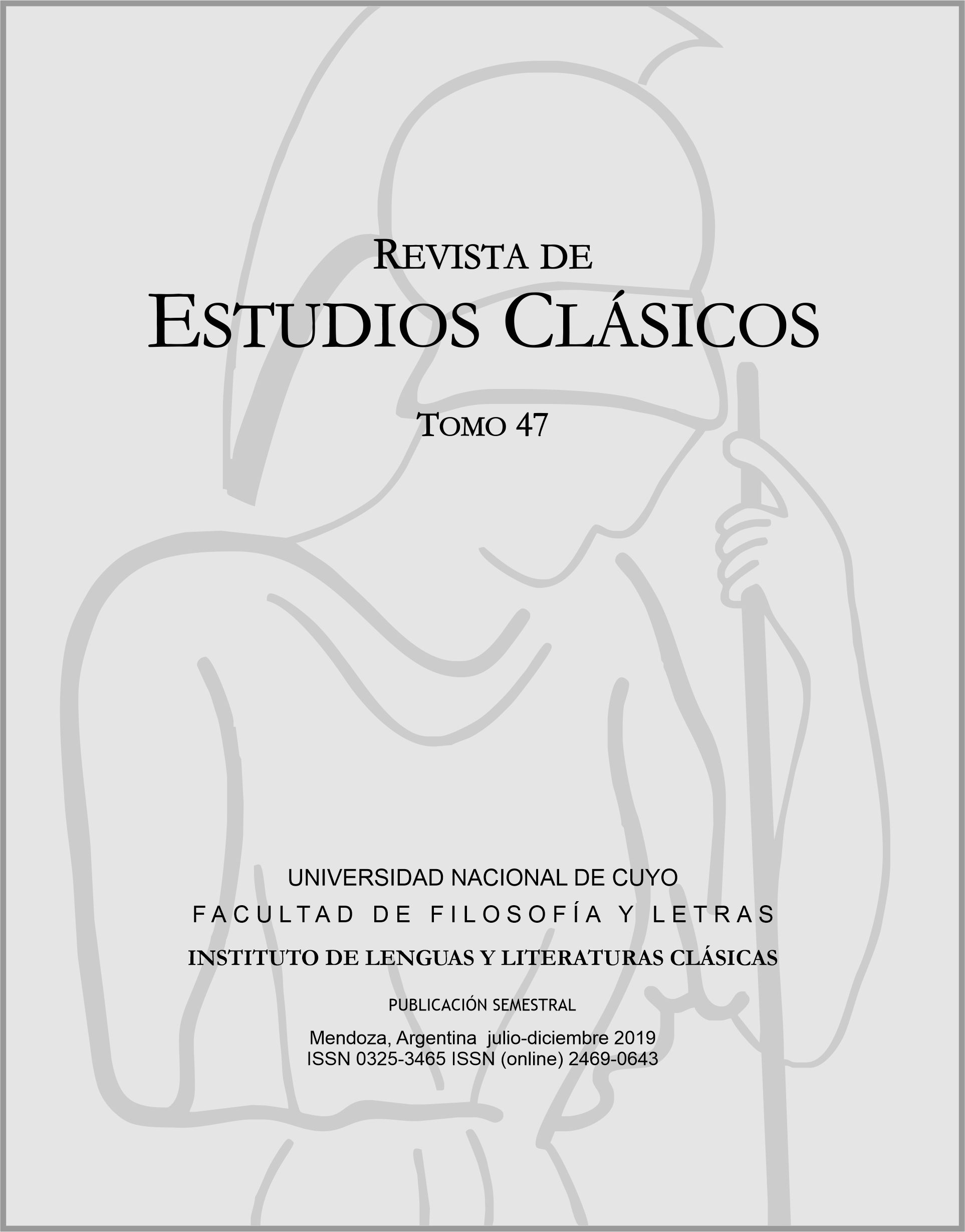Female characters in Aeneid
About the singular configuration in En. 2, 506-525
Keywords:
Aeneid, female characters, Hecuba, TroyAbstract
In the context of the account of the fall of Troy, the narrative voice turns to Priam’s palace (Aen. 2, 506-525). There, queen Hecuba admonishes her husband for willing to wear his old armor and trying to join the battle. To act in that way, she tells him, is to obey to a mens dira which is not appropriate for those circumstances. Troy has already fallen: the only thing that remains is either to hope for the gods’ help or to die. We consider this passage especially interesting for the configuration of Hecuba’s character, which from our viewpoint does not meet the usual paradigm of irrationality, excessive passion and unproductive suffering usually adjudicated to female characters in the Aeneid (cf. Oliensis 1997, Nugent 1999, Keith 2004 and Foley 2005, among others).
References
Austin, R. G. (1964). P. Vergili Maronis Aeneidos Liber Secundus. Oxford: Clarendon Press.
Block, E. (1984). The Effects of Divine Manifestation on the Reader’s Perspective in Vergil’s Aeneid. Salem: Arno.
Bowie, A. (2008) Aeneas Narrator. PVS 26, pp. 41-51.
Foley, H. (2005) Women in Ancient Epic. En Foley, J. M. (ed.), A Companion to Ancient Epic (pp. 105-118). Oxford: Blackwell.
Fuqua, C. (1982). Hector, Sychaeus, and Deiphobus: Three Mutilated Figures in Aeneid 1-6. CPh 77.3, pp. 235-240.
Ganiban, R. T. (2012) Aeneid Books 1-6. Indianapolis: Focus.
Gransden, K. W. (1985). The Fall of Troy. G&R 32.1, pp. 60-72.
Grillo, L. (2010). Leaving Troy and Creusa: Reflections on Aeneas’ Flight. CJ 106.1, pp. 43-68.
Hallet, J. (2002). Feminae Furentes: The Frenzy of Noble Women in Vergil’s Aeneid and the Letter of Cornelia, Mother of the Gracchi. En Anderson, W. y Quartarone, L (eds.), Approaches to Teaching Vergil’s Aeneid (pp. 159-167). Nueva York: Modern Language Association of America.
Horsfall, N. (1998) Virgil, Aeneid 2. A Commentary, Leiden-Boston: Brill.
Johnson, W. R. (1999) Dis Aliter Visum: Self-Telling and Theodicy in Aeneid 2. En Perkell, C. (ed.), Reading Vergil’s Aeneid. An Interpretive Guide (pp. 50-63). Norman: University of Oklahoma Press.
Keith, A. M. (2004) Engendering Rome. Women in Latin Epic. Cambridge: Cambridge University Press.
Mitchell, R. (1991) The Violence of Virginity in the Aeneid. Arethusa 24.2, pp. 219-238.
Mynors, R. (1969) Vergili Maronis Opera. Oxford: Clarendon Press.
Nugent, S. G. (1992) Vergil’s ‘Voice of the Women’ in Aeneid V. Arethusa 25, pp. 255-292.
Nugent, S. G. (1999). The Women of the Aeneid: Vanishing Bodies, Lingering Voices. En Perkell, C. (ed.), Reading Vergil’s Aeneid. An Interpretive Guide (pp. 251-270) Norman: University of Oklahoma Press.
Oliensis, E. (1997) Sons and Lovers. Sexuality and Gender in Virgil's Poetry. En Martindale, C. (ed.), The Cambridge Companion to Virgil (pp. 294-311). Cambridge: Cambridge University Press.
O’Sullivan, T. (2009). Death ante ora parentum in Vergil’s Aeneid. TAPA 139.2, pp. 447-486.
Perkell, C. (1992). On Creusa, Dido, and the quality of victory in Virgil’s. en Foley, H. (ed.), Reflections of Women in Antiquity (pp. 355-377) Londres: Routledge.
Sklenár, R. J. (1990). The Death of Priam: Aeneid 2.506-558. Hermes 118.1, pp. 67-75.
Sullivan, J. P. (1992) Dido and the Representation of Women in Vergil’s Aeneid. En Wilhelm, R. y Jones, H. (eds.) The Two Worlds of the Poet. New Perspectives on Vergil (pp. 64-73). Detroit: Wayne State University Press.
Syed, Y. (2005) Vergil’s Aeneid and the Roman Self. Subject and Nation in the Literary Discourse. Ann Arbor: The University of Michigan Press.
Downloads
Published
How to Cite
Issue
Section
License
Aquellos autores/as que tengan publicaciones con esta revista, aceptan los términos siguientes:
- Los autores/as conservarán sus derechos de autor y garantizarán a la revista el derecho de primera publicación de su obra, el cuál estará simultáneamente sujeto a laLicencia Creative Commons Atribución-NoComercial-CompartirIgual 2.5 Argentina (CC BY-NC-SA 2.5 AR). (https://creativecommons.org/licenses/by-nc-sa/2.5/ar/)que permite a terceros compartir la obra siempre que se indique su autor y su primera publicación esta revista.
- Los autores/as podrán adoptar otros acuerdos de licencia no exclusiva de distribución de la versión de la obra publicada (p. ej.: depositarla en un archivo telemático institucional o publicarla en un volumen monográfico) siempre que se indique la publicación inicial en esta revista.
- Se permite y recomienda a los autores/as difundir su obra a través de Internet (p. ej.: en archivos telemáticos institucionales o en su página web) antes y durante el proceso de envío, lo cual puede producir intercambios interesantes y aumentar las citas de la obra publicada. (Véase El efecto del acceso abierto).


































